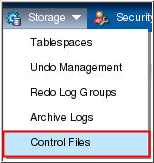 Before You Begin
Before You Begin
This 10-minute tutorial shows you how to use Enterprise Manager Express to explore the structure of your database.
Select the Oracle Database release:
Background
An Oracle database is made up of physical and logical structures. Physical structures are visible in the operating system. An example of a physical structure is an operating system file that stores data on a disk. Logical structures are defined and known to the Oracle Database server, but are not known to the operating system. An example of a logical structure is a tablespace. In this tutorial you will view logical structures in your database and understand how they relate to physical structures in the operating system.
What Do You Need?
- Oracle Database 18c19c
 View
Control File Information
View
Control File Information
An Oracle database is made up of physical and logical structures. Physical structures are defined in the operating system. Physical files that store data on a disk are an example of a physical structure. Logical structures are defined in the database and are not known in the operating system. To view storage structure information, perform the following steps:
- Enter the URL for Enterprise Manager Database Express in
your browser and log in as the SYSTEM user.

Description of the illustration a1 Note:Starting with Oracle Database 19c, Oracle EM Express, the default management option for Oracle Database, is based on Java JET technology. Currently, only the Performance menu is available in the 19c JET version. Therefore, we are using the 18c Flash Oracle EM Express in our tutorials. Use the following command to revert to Flash Oracle EM Express:
SQL> @?/rdbms/admin/execemx emx
To return to 19c JET Oracle EM Express, use the following command:
SQL> @?/rdbms/admin/execemx omx
- Select Control Files
in the Storage menu.

Description of the illustration a2 - The Control Files page is displayed. The Control File
Information section provides information about the creation
and most recent modification to the control file. In the List
of Control Files section, the control file names are provided.
More than one file name indicates that the control file is
multiplexed. The Control File Sections section provides
information about the data that is stored in the control file.

Description of the illustration a3 - Click ORCL to return to the Database Home page.
 View
Online Redo Log Information
View
Online Redo Log Information
- Select Redo Log Groups
in the Storage menu.

Description of the illustration b1 - The Redo Log Groups page is displayed. This page lists the
redo log groups that have been configured for your database. A
value of Current in the Status column indicates the group that
is currently being written to. If the redo log groups are
multiplexed, more than one member is shown for the group.
Note: In this tutorial, the current group is Redo Log Group 3. The current group may differ when you perform this tutorial.
Description of the illustration b2 - Click ORCL to return to the Database Home page.
 Viewing
Archived Redo Log Information
Viewing
Archived Redo Log Information
- Select Archive Logs in
the Storage menu.

Description of the illustration c1 - The Archive Logs page is displayed. If your database is not
in ARCHIVELOG mode, you will not have any archived redo log
files.

Description of the illustration c2 - Click ORCL to return to the Database Home page.
